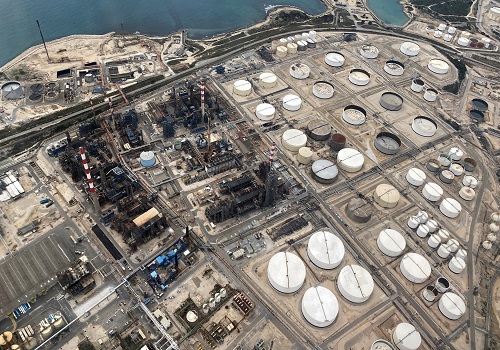Zinc trading range for the day is 239.5-245.9 - Kedia Advisory

Follow us Now on Telegram ! Get daily 10 - 12 important updates on Business, Finance and Investment. Join our Telegram Channel
Gold
Gold exhibited resilience in yesterday's trading session, gaining 0.54% to settle at 71644, fueled by persistent concerns surrounding geopolitical tensions. The yellow metal attracted safe-haven buying amidst lingering uncertainties, highlighting its enduring status as a hedge against market volatility. The release of the Consumer Price Index (CPI) report by the Labor Department provided further momentum to gold prices, as inflationary pressures exceeded expectations with a 0.4% monthly increase in March. However, the Shanghai Futures Exchange's decision to impose trading limits on gold contracts in response to a sharp price rally added a note of caution to the market. Internationally, Federal Reserve officials expressed concerns about the trajectory of inflation, suggesting a potential need for a longer period of tight monetary policy to curb price increases. This cautious stance from the U.S. central bank further underpinned gold's appeal as a hedge against inflationary pressures. Meanwhile, the World Gold Council (WGC) reported continued outflows from global physically backed gold exchange-traded funds (ETFs) for the 10th consecutive month. However, the pace of outflows slowed in March, with North American and Asian inflows offsetting European losses. This nuanced trend reflects diverging investor sentiments across regions amidst evolving market dynamics. From a technical standpoint, gold is currently experiencing fresh buying interest, supported by a 1.29% increase in open interest and a substantial price gain of 386 rupees. The metal finds immediate support at 71260, with a potential downside test towards 70870. On the upside, resistance is anticipated at 71860, with a breakthrough potentially leading to further testing of 72070 levels.
Trading Ideas:
* Gold trading range for the day is 70870-72070.
* Gold gains amid lingering concerns about geopolitical tensions
* Stronger-than-expected inflation print softened expectations of an early U.S. rate cut.
* HSBC expects to see a wide trading range of $1,975-$2,500 for gold prices in 2024.
Silver
Silver exhibited a modest gain of 0.28% yesterday, closing at 82,847, as investors grappled with conflicting US inflation data and its potential impact on the Federal Reserve's monetary policy. Federal Reserve officials expressed concerns in their March meeting minutes that progress on inflation may have stagnated, prompting deliberation over the need for an extended period of tight monetary policy to curb rising prices. Despite this, the baseline view for three interest rate cuts in 2024 remained intact. However, prospects for an early interest-rate cut by the Federal Reserve received a setback with another US inflation report indicating persistent price pressures across the economy. Traders are now eyeing the Fed's mid-September meeting for a potential rate reduction, following stronger-than-expected consumer inflation readings for the third consecutive month. The latest report from the Labor Department's Bureau of Labor Statistics revealed a 0.4% increase in the consumer price index for March, driven by higher gasoline and shelter costs, further clouding the outlook for rate cuts. From a technical standpoint, the silver market witnessed fresh buying interest, with open interest rising by 0.52% to settle at 27,643 contracts, accompanied by a significant price surge of 232 rupees. Support for silver is identified at 82,340, with potential downside towards 81,840. Conversely, resistance is anticipated at 83,125, with a breakout potentially leading to testing of 83,410 levels.
Trading Ideas:
* Silver trading range for the day is 81840-83410.
* Silver gains as geopolitical tensions continued to boost demand for the safe-haven metal
* Fed's 'confidence' in disinflation not helped by recent data, minutes show
* Fed seen cutting US interest rates later, and less, as inflation stays hot
Crude oil
Yesterday, crude oil prices experienced a decline of -0.7%, settling at 7109, as market sentiment was influenced by a mixed bag of supply data and demand outlook. The EIA report revealed a significant increase in U.S. crude inventories, surpassing market expectations with a rise of 5.8 million barrels to 457.3 million barrels. This unexpected buildup in inventories exerted downward pressure on prices, reflecting concerns about oversupply in the market. On the demand side, OPEC maintained its optimistic outlook, predicting robust fuel usage during the summer months and reaffirming its forecast for relatively strong growth in global oil demand for 2024. Despite ongoing geopolitical risks, the organization sees no change in its projections, anticipating a rise in world oil demand by 2.25 million bpd in 2024 and by 1.85 million bpd in 2025. However, the supply side presents a different picture, with the U.S. EIA revising its estimates for U.S. crude oil output upwards for this year and the next. The agency anticipates a slight increase in production, forecasting output to reach 13.21 million bpd in 2024 and 13.72 million bpd in 2025. Additionally, the EIA revised its price forecasts upwards, reflecting expectations of strong global oil inventory draws and ongoing geopolitical uncertainties. From a technical perspective, the market witnessed long liquidation, indicated by a significant drop in open interest by -13.61% alongside a decline in prices. Crude oil is currently finding support at 7071, with a potential downside test towards 7032. Conversely, resistance is anticipated at 7159, with a breakthrough potentially leading to further testing of 7208 levels.
Trading Ideas:
* Crudeoil trading range for the day is 7032-7208.
* Crude oil dropped as U.S. crude, gasoline and distillate inventories rose
* OPEC predicted robust fuel use in the summer months and stuck to its forecast.
* U.S. crude oil output is set to grow slightly more than earlier estimates for this year and next.
Natural gas
Natural gas prices experienced a significant decline of -6.34% yesterday, settling at 147.7, driven by forecasts indicating lower demand than previously anticipated, primarily attributed to a drop in feedgas to the Freeport LNG export plant in Texas. This unexpected development has shifted market sentiment, with utilities in the US increasing their storage of natural gas by 24 billion cubic feet (bcf) during the week ended April 5th, surpassing market expectations and marking the first increase in three weeks. The surge in storage levels contrasts sharply with the five-year average decline for this time of year, indicating a notable shift in supply dynamics. Additionally, gas output in the Lower 48 US states has witnessed a decline to a preliminary 12-week low, attributed to factors such as reduced demand and operational adjustments. With warmer weather on the horizon, forecasts predict a further decline in gas demand in the Lower 48, including exports, signaling potential challenges for market participants.From a technical perspective, the market witnessed fresh selling pressure, as evidenced by a significant increase in open interest by 25.63% to settle at 61,255 contracts, coupled with a decline in prices by -10 rupees. Support for natural gas is identified at 144.3, with potential downside towards 140.9, while resistance is anticipated at 154, with a breakout potentially leading to testing of 160.3 levels.
Trading Ideas:
* Naturalgas trading range for the day is 140.9-160.3.
* Natural gas prices fell due to lower demand forecasts.
* US utilities increased their storage of natural gas by 24 billion cubic feet.
* Gas output in Lower 48 U.S. states fell to an average of 98.9 billion cubic feet per day (bcfd) so far in April
Copper
Copper prices faced downward pressure in yesterday's trading session, closing lower by -0.31% at 816.55, influenced by weak consumer inflation data from China and a strengthening dollar. China's cooling consumer inflation and persistent producer price deflation highlighted ongoing demand weakness in the world's largest copper consumer, dampening sentiment in the copper market. Concurrently, U.S. inflation data surpassed expectations, delaying the anticipated timeline for a first rate cut, which further bolstered the dollar and weighed on copper prices. The Shanghai Futures Exchange's decision to impose restrictions on maximum intraday position opening volumes for copper contracts added to market concerns. These restrictions, effective from April 12, signal efforts to manage volatility and maintain stability in copper trading, reflecting the exchange's proactive approach to market regulation. On the supply side, disruptions in major African mines, compounded by setbacks in key mines in Panama and South America, led Anglo American to downgrade its copper production guidance. Additionally, Chile's copper exports in March declined by 5.5% year-on-year, according to the central bank, indicating challenges in export volumes amidst global economic uncertainties. In Japan, refined copper production is expected to rise by 4.2% in the first half of the 2024/25 financial year, driven by stronger local demand from the chip industry, offering a glimmer of demand optimism amidst broader market challenges. From a technical perspective, copper is witnessing fresh selling pressure, indicated by an increase in open interest and a decline in prices. The metal currently finds support at 813.8, with a potential downside test towards 810.8. Conversely, resistance is anticipated at 820, with a breakthrough potentially leading to further testing of 823.2 levels.
Trading Ideas:
* Copper trading range for the day is 810.8-823.2.
* Copper prices edged lower on weak consumer inflation data in China and a firm dollar.
* Data showed China's consumer inflation cooled more than expected in March
* SHFE will begin restrictions on the maximum intraday position opening volumes for the copper contract from April 12.
Zinc
Zinc prices registered a modest gain of 0.33% yesterday, settling at 243.5, propelled by growing optimism surrounding the global manufacturing sector, amid indications that the manufacturing slump may have bottomed out. This positive sentiment was further reinforced by U.S. inflation data, which surpassed expectations for March, subsequently delaying the anticipated timing of a first rate cut to September from June. In March 2024, China's refined zinc production witnessed a month-on-month increase of 4.57%, totaling 525,500 metric tons. However, on a year-on-year basis, there was a decline of 5.61%, reflecting broader economic dynamics impacting the industry. Despite the fluctuations, the total output from January to March slightly exceeded expectations, indicating resilience within the sector. Domestic zinc alloy production, however, experienced a slight month-on-month decrease in March. The revision of China's sovereign credit outlook by Fitch Ratings from stable to negative on April 9th underscored mounting concerns over the nation's public finance outlook. This shift in outlook was attributed to significant fiscal deficits and a surge in government debt in recent years, which have eroded fiscal buffers. From a technical standpoint, the zinc market witnessed fresh buying interest, with open interest rising by 4.39% to settle at 3,523 contracts, accompanied by a price increase of 0.8 rupees. Support for zinc is identified at 241.5, with potential downside towards 239.5, while resistance is anticipated at 244.7, with a breakout potentially leading to testing of 245.9 levels.
Trading Ideas:
* Zinc trading range for the day is 239.5-245.9.
* Zinc gains propelled by increasing conviction that the global manufacturing slump has bottomed out.
* Data showed that China's refined zinc production was 525,500 mt, an increase of 4.57% month-on-month
* Fitch Ratings revised China’s sovereign credit outlook from stable to negative
Aluminium
Aluminium prices experienced a marginal decline of -0.13% in yesterday's trading session, settling at 224.1, influenced by mixed signals from China's aluminium output and economic outlook. China's aluminium production in March witnessed a notable year-on-year increase of 4.19%, reaching 3.555 million metric tons, signaling a recovery from the impact of the Chinese New Year holidays. The return to normal production levels and a rise in the share of aluminium liquid output contributed to stability in the domestic aluminium market. Looking ahead, further production resumptions are anticipated in mid-April, potentially boosting production levels in April, albeit with regional variations. Domestic aluminium operating capacity is projected to increase by 250,000 metric tons by the end of April, reflecting ongoing efforts to meet demand amidst improving economic conditions. Goldman Sachs revised its forecast for China's economic growth upwards to 5.0%, citing manufacturing strength as a key driver. This upward revision aligns with the first-quarter GDP growth forecast, also raised to 5.0%, indicating optimism about the trajectory of China's economic recovery. However, Fitch's revision of its outlook on China to negative introduces a note of caution, citing increasing risks to the country's public finance outlook. Fitch forecasts a rise in the general government deficit to 7.1% of GDP in 2024, reflecting concerns about fiscal sustainability amidst evolving economic challenges. Technically, the aluminium market witnessed fresh selling pressure, with an increase in open interest and a slight decline in prices. Aluminium is currently finding support at 223.1, with a potential downside test towards 222.1. Conversely, resistance is anticipated at 225, with a breakthrough potentially leading to further testing of 225.9 levels.
Trading Ideas:
* Aluminium trading range for the day is 222.1-225.9.
* Aluminium dropped as China's aluminium output was 3.555 million mt in March, up 4.19% YoY.
* The first batch of production resumption may be completed in mid-April, boosting production in April
* Goldman Sachs lifts China 2024 growth forecast to 5.0%
Cottoncandy
Cottoncandy prices experienced a notable decline of -1.86% yesterday, settling at 60,120, primarily driven by muted global demand and the anticipation of a better crop in countries like Australia. The International Cotton Advisory Committee (ICAC) projected increases in cotton-producing areas, production, consumption, and trade for the next season, 2024-25. Projections indicate a 3% increase in cotton-producing area, a 2.5% rise in production, a 2.9% increase in consumption, and a nearly 4% growth in global cotton trade compared to the previous season. Domestically, the Cotton Association of India (CAI) and the Cotton Corporation of India (CCI) revised their cotton production estimates upwards for the current season, highlighting expectations of higher output. However, India's cotton production for MY 2024/25 is estimated to decrease by 2% due to anticipated shifts in acreage towards other crops with higher returns. Similarly, China's cotton imports for MY 2024/25 are forecasted to increase to meet higher demand for textile and apparel products. The rebound in exports of textile and apparel products, coupled with increased demand, is expected to drive imports. In the spot market, prices in Rajkot, a major cotton trading hub, saw a marginal decline of -0.02% to end at 28,864.5 Rupees. From a technical perspective, the cotton market is witnessing long liquidation, indicated by a decrease of -0.9% in open interest to settle at 438 contracts, coupled with a significant price drop of -1,140 rupees. Support for Cottoncandy is identified at 59,980, with potential downside towards 59,850, while resistance is anticipated at 60,260, with a breakout potentially leading to testing of 60,410 levels.
Trading Ideas:
* Cottoncandy trading range for the day is 59850-60410.
* Cotton dropped on muted global demand and prospects of a better crop in countries such as Australia.
* The ICAC's projections for 2024-25 suggest that the cotton-producing area may increase by 3 per cent from the 2023-24 acreage
* For 2024/25 China’s cotton imports are forecast at 2.4 million metric tons
* In Rajkot, a major spot market, the price ended at 28864.5 Rupees dropped by -0.02 percent.
Turmeric
Turmeric prices witnessed a notable decline of -1.88% in yesterday's trading session, settling at 16742, primarily driven by expectations of new arrivals from the Marathwada region in Maharashtra. However, the downside was limited due to below-normal supplies and active festive demand, reflecting a delicate balance between supply dynamics and market sentiment. The influx of new crop supply, particularly from key markets such as Nanded, Nizamabad, and Erode, contributed to the downward pressure on prices. These arrivals, which were over 25% higher compared to the previous week, added to market liquidity but also underscored the challenges of managing supply fluctuations amidst evolving demand patterns. Despite the uptick in arrivals, the overall supply situation remains below normal, providing some support to prices. The Ministry of Agriculture and Farmers’ Welfare's first advance estimate for turmeric production in 2023-24 indicates a decline compared to the previous year, reflecting factors such as demand destruction amid surging prices and expectations of increased sowing areas in key growing regions. On the export front, turmeric exports during Apr-Jan 2024 experienced a marginal decline of 3.52% compared to the same period in the previous year. However, there was a slight uptick in exports in January 2024 compared to December 2023, albeit with a year-on-year decline. From a technical perspective, the market witnessed fresh selling pressure, with an increase in open interest and a substantial decline in prices. Turmeric is currently finding support at 16628, with a potential downside test towards 16514. Conversely, resistance is anticipated at 16938, with a breakthrough potentially leading to further testing of 17134 levels.
Trading Ideas:
* Turmeric trading range for the day is 16514-17134.
* Turmeric dropped as new arrivals are expected from the Marathwada region in Maharashtra.
* New crop supply has increased by over 25% in parts of Tamil Nadu, Telangana, and Andhra Pradesh
* The Ministry of Agriculture first advance estimate for turmeric production in 2023-24 is estimated at 10.74 lakh tonnes
* In Nizamabad, a major spot market, the price ended at 16576.8 Rupees gained by 1.1 percent.
Jeera
Jeera prices faced a decline of -1.7% yesterday, settling at 22,890, primarily due to the anticipation of increased arrivals in the market. However, the downside was limited as global buyers continued to prefer Indian jeera amidst tightening global supplies. The market witnessed daily arrivals of 10,000 to 12,000 bags in the Rajkot Mandi, surpassing current demand levels. New arrivals have been observed in Gujarat and Rajasthan, leading to concerns about oversupply. The surge in production in major cumin-producing regions, including Gujarat and Rajasthan, has contributed to the record production of cumin in India. The total production in Gujarat is estimated to reach 4.08 lakh tonnes, marking a significant increase from previous years. Similarly, Rajasthan witnessed a 53% increase in cumin production. Despite the increase in production, trade analysts anticipate a substantial rise in cumin exports in February 2024, attributed to the decline in international prices and increased sowing areas. However, jeera exports during April-January 2024 experienced a decline of 25.33% compared to the same period in the previous year, totaling 109,097.06 tonnes. Despite this decline, January 2024 saw a notable increase in exports compared to December 2023 and January 2023, indicating potential shifts in export trends. In the spot market, prices in Unjha, a major trading hub, increased by 0.72% to end at 24,112.15 Rupees, reflecting some resilience amidst the overall downward trend. From a technical standpoint, the jeera market is experiencing fresh selling pressure, with open interest rising by 8.9% to settle at 2,496 contracts, accompanied by a price decline of -395 rupees. Support for jeera is identified at 22,630, with potential downside towards 22,370, while resistance is anticipated at 23,300, with a breakout potentially leading to testing of 23,710 levels.
Trading Ideas:
* Jeera trading range for the day is 22370-23710.
* Jeera dropped as there is a possibility of further increase in arrivals pressure in the market.
* There will be a huge increase in cumin exports, which will reach about 14-15 thousand tonnes in February 2024.
* New arrivals have started in Gujarat since last 20-25 days and new arrivals have started in Rajasthan also since last 15 days.
* In Unjha, a major spot market, the price ended at 24112.15 Rupees gained by 0.72 percent.
Views express by all participants are for information & academic purpose only. Kindly read disclaimer before referring below views. Click Here For Disclaimer




















